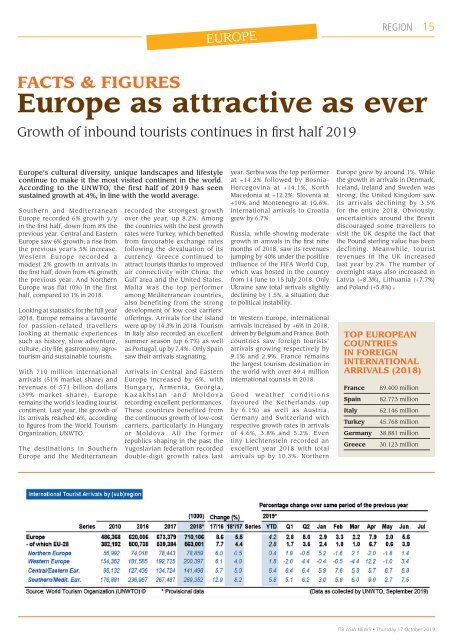ITB Asia News 2019 Day 2 Edition
- No tags were found...
You also want an ePaper? Increase the reach of your titles
YUMPU automatically turns print PDFs into web optimized ePapers that Google loves.
EUROPE<br />
REGION<br />
15<br />
FACTS & FIGURES<br />
Europe as attractive as ever<br />
Growth of inbound tourists continues in first half <strong>2019</strong><br />
Europe’s cultural diversity, unique landscapes and lifestyle<br />
continue to make it the most visited continent in the world.<br />
According to the UNWTO, the first half of <strong>2019</strong> has seen<br />
sustained growth at 4%, in line with the world average.<br />
Southern and Mediterranean<br />
Europe recorded 6% growth y/y<br />
in the first half, down from 8% the<br />
previous year. Central and Eastern<br />
Europe saw 6% growth; a rise from<br />
the previous year’s 5% increase.<br />
Western Europe recorded a<br />
modest 2% growth in arrivals in<br />
the first half, down from 4% growth<br />
the previous year. And Northern<br />
Europe was flat (0%) in the first<br />
half, compared to 1% in 2018.<br />
Looking at statistics for the full year<br />
2018, Europe remains a favourite<br />
for passion-related travellers<br />
looking at thematic experiences<br />
such as history, slow adventure,<br />
culture, city life, gastronomy, agrotourism<br />
and sustainable tourism.<br />
With 710 million international<br />
arrivals (51% market share) and<br />
revenues of 571 billion dollars<br />
(39% market share), Europe<br />
remains the world’s leading tourist<br />
continent. Last year, the growth of<br />
its arrivals reached 6%, according<br />
to figures from the World Tourism<br />
Organization, UNWTO.<br />
The destinations in Southern<br />
Europe and the Mediterranean<br />
recorded the strongest growth<br />
over the year, up 8.2%. Among<br />
the countries with the best growth<br />
rates were Turkey, which benefited<br />
from favourable exchange rates<br />
following the devaluation of its<br />
currency. Greece continued to<br />
attract tourists thanks to improved<br />
air connectivity with China, the<br />
Gulf area and the United States.<br />
Malta was the top performer<br />
among Mediterranean countries,<br />
also benefiting from the strong<br />
development of low cost carriers’<br />
offerings. Arrivals for the island<br />
were up by 14.3% in 2018. Tourism<br />
in Italy also recorded an excellent<br />
summer season (up 6.7%) as well<br />
as Portugal, up by 7.4%. Only Spain<br />
saw their arrivals stagnating.<br />
Arrivals in Central and Eastern<br />
Europe increased by 6%, with<br />
Hungary, Armenia, Georgia,<br />
Kazakhstan and Moldova<br />
recording excellent performances.<br />
These countries benefited from<br />
the continuous growth of low-cost<br />
carriers, particularly in Hungary<br />
or Moldova. All the former<br />
republics shaping in the past the<br />
Yugoslavian federation recorded<br />
double-digit growth rates last<br />
year. Serbia was the top performer<br />
at +14.2% followed by Bosnia-<br />
Hercegovina at +14.1%, North<br />
Macedonia at +12.2%. Slovenia at<br />
+10% and Montenegro at 10.6%.<br />
International arrivals to Croatia<br />
grew by 6.7%.<br />
Russia, while showing moderate<br />
growth in arrivals in the first nine<br />
months of 2018, saw its revenues<br />
jumping by 40% under the positive<br />
influence of the FIFA World Cup,<br />
which was hosted in the country<br />
from 14 June to 15 July 2018. Only<br />
Ukraine saw total arrivals slightly<br />
declining by 1.5%, a situation due<br />
to political instability.<br />
In Western Europe, international<br />
arrivals increased by +6% in 2018,<br />
driven by Belgium and France. Both<br />
countries saw foreign tourists’<br />
arrivals growing respectively by<br />
9.1% and 2.9%. France remains<br />
the largest tourism destination in<br />
the world with over 89.4 million<br />
international tourists in 2018.<br />
Good weather conditions<br />
favoured the Netherlands (up<br />
by 6.1%) as well as Austria,<br />
Germany and Switzerland with<br />
respective growth rates in arrivals<br />
of 4.6%, 3.8% and 5.2%. Even<br />
tiny Liechtenstein recorded an<br />
excellent year 2018 with total<br />
arrivals up by 10.3%. Northern<br />
Europe grew by around 1%. While<br />
the growth in arrivals in Denmark,<br />
Iceland, Ireland and Sweden was<br />
strong, the United Kingdom saw<br />
its arrivals declining by 3.5%<br />
for the entire 2018. Obviously,<br />
uncertainties around the Brexit<br />
discouraged some travellers to<br />
visit the UK despite the fact that<br />
the Pound sterling value has been<br />
declining. Meanwhile, tourist<br />
revenues in the UK increased<br />
last year by 2%. The number of<br />
overnight stays also increased in<br />
Latvia (+8.3%), Lithuania (+7.7%)<br />
and Poland (+5.8%)<br />
TOP EUROPEAN<br />
COUNTRIES<br />
IN FOREIGN<br />
INTERNATIONAL<br />
ARRIVALS (2018)<br />
France<br />
Spain<br />
Italy<br />
Turkey<br />
Germany<br />
Greece<br />
89.400 million<br />
82.773 million<br />
62.146 million<br />
45.768 million<br />
38.881 million<br />
30.123 million<br />
<strong>ITB</strong> ASIA NEWS • Thursday 17 October <strong>2019</strong>

















